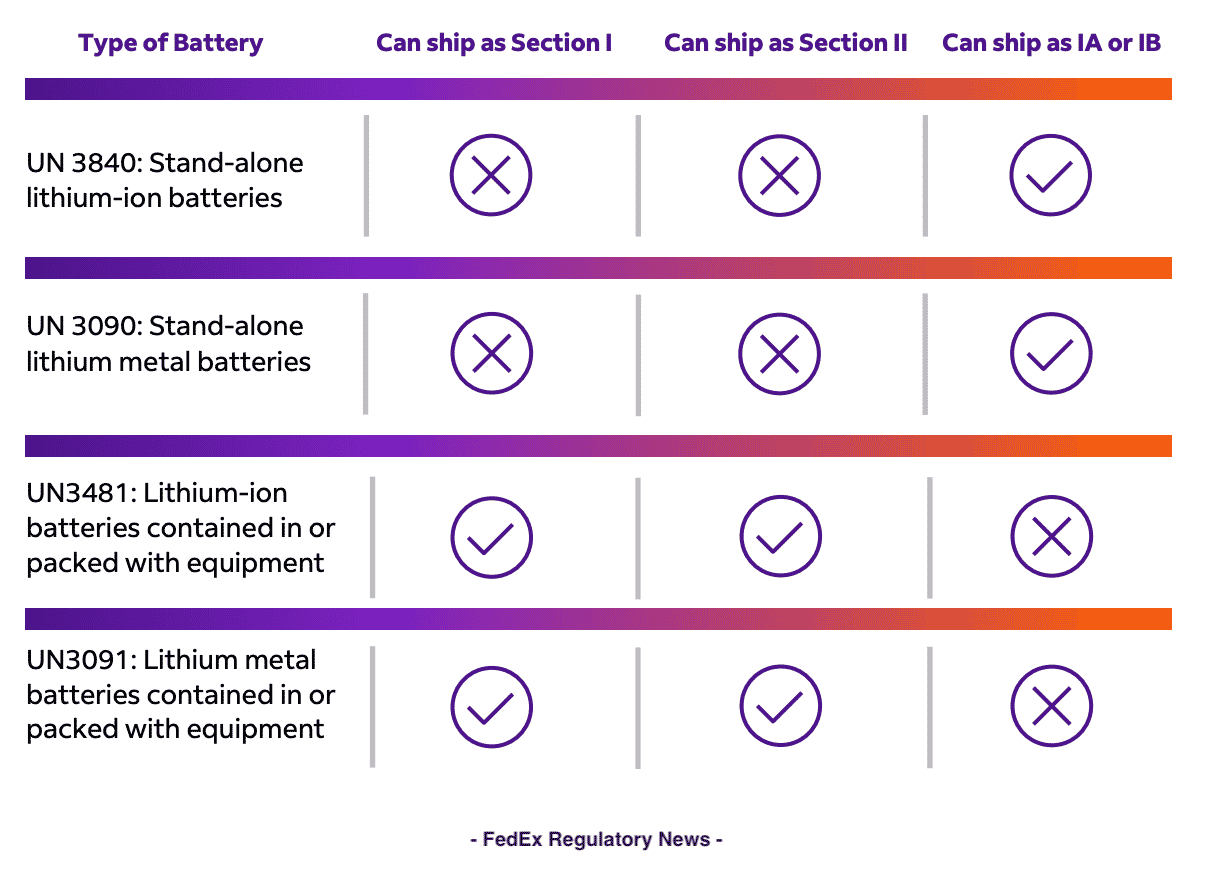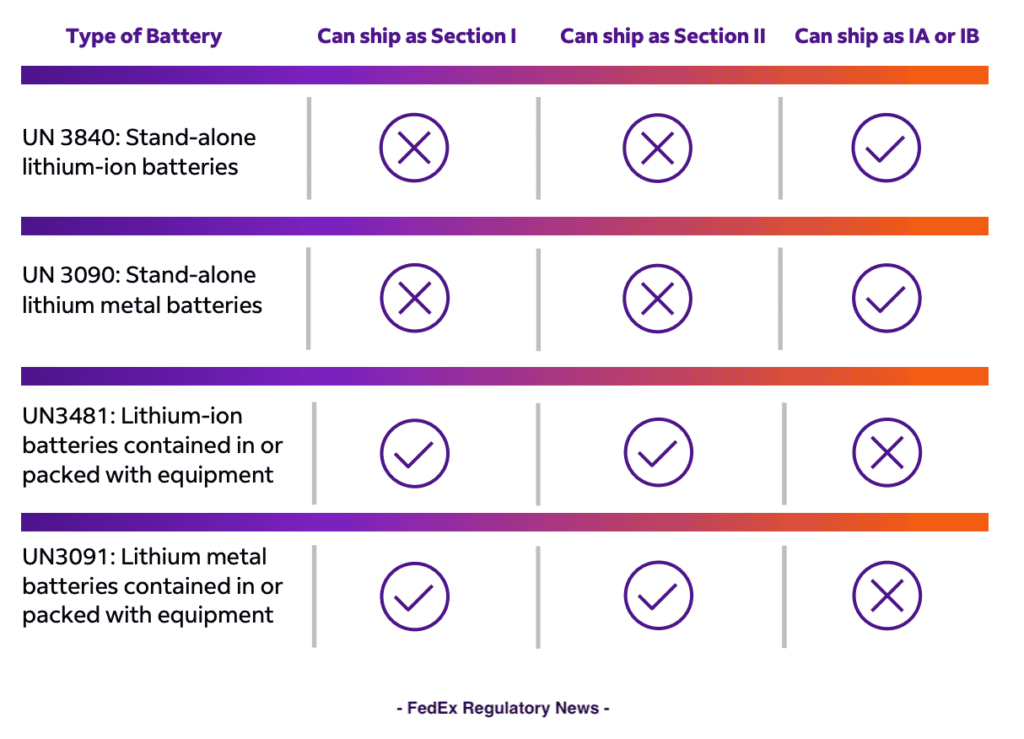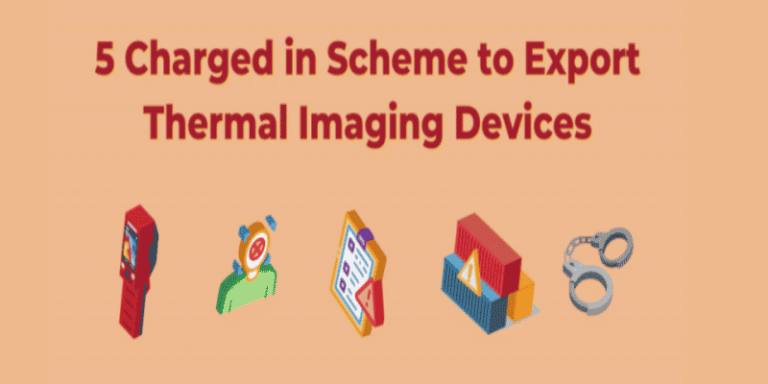Air Transportation of Lithium Metal and Lithium-Ion Batteries Revised for the 2022 Regulations
REGULATORY UPDATE
The International Air Transport Association (IATA) now forbids shipping stand-alone lithium metal batteries, UN3090, and stand-alone lithium-ion batteries, UN3480, classified as Section II shipments via air. Section II shipments are smaller shipments of lithium batteries that had previously been granted exceptions for many of the IATA’s dangerous air goods shipping rules.
The updated regulation became effective January 1, 2022, with certain air carriers allowing shippers until March 31, 2022, to transition. This regulation applies to all global shipments regardless of origin and destination.
You can still ship stand-alone lithium batteries if they comply with either Section IA or IB of the IATA Dangerous Goods Regulations (DGR) packing instructions 965 and 968, which are fully regulated dangerous goods shipments that require the Shipper’s Declaration for Dangerous Goods to be completed and signed by a trained shipper.
BACKGROUND
The IATA has released the 2022 edition of their Lithium Battery Guidance Document, which includes updated regulations that ensure lithium batteries are being transported safely.
Lithium batteries pose a danger to air transport. They can self-ignite during flights if damaged or packaged improperly. Previously, shippers could send a certain number of stand-alone, small lithium-ion and lithium-metal batteries, such as typical consumer batteries sold in packs, and spare or replacement batteries for electronic devices, using an air transport shipping option Section II. This option mandated an extremely low number of batteries per package when shipped, aiming to prevent high concentrations of lithium batteries traveling via air, and reducing the risk of fires.
WHAT THIS MEANS FOR YOU AND YOUR CUSTOMERS
If your business ships stand-alone lithium batteries via air, you should contact your local FedEx Sales Professional for help finding another FedEx shipping option. Some carriers are not participating in the transition time and stopped allowing Section II shipments as of January 1.
You could also experience other impacts:
- Additional labels and paperwork for shipments
- Additional dangerous goods fees with airlines
- Possible capacity and transit constraints during the transition period
- The need to source alternative transportation methods
HOW TO PREPARE
Here are some important steps you can take to make sure you’re prepared for this change:
- Read the IATA 2022 Lithium Battery Guidance Document, which includes a flowchart that can help you properly classify your lithium batteries. For more information on what types of shipments specific air carriers will accept, consult section 2.8.4 of the IATA Dangerous Goods Regulations Manual. Be sure to obtain a copy online if you don’t already have one.
- Determine if the regulation update applies to your lithium battery shipments and if the selected carrier has extended the deadline for compliance.
- Familiarize your company with the new labeling, package markings, documentation requirements, and proper packaging requirements.
- Consult your internal dangerous goods resource with any questions.
- Make an internal company plan to adjust your processes.
- Validate what type of lithium battery shipments the selected air carrier allows.
When shipping dangerous goods, it’s important to remember that proper labeling, packaging, documentation, and marking are the sole responsibility of the shipper. As the shipper, you are also responsible for determining if the selected carrier has extended the compliance deadline to March 31, 2022.
Q&A
Q: When will this regulation take effect?
A: The updated regulation took effect on January 1, 2022. However, depending on the air carrier, some shippers have until March 31, 2022, to explore alternate shipping options.
Q: Where can I get more information about lithium battery shipping regulations?
A: Consult the full 2022 Lithium Battery Guidance Document for more information about all the updates to the regulation, including more about lithium batteries and how to ship them properly and safely.
Q: Does the January 1, 2022 IATA rule change impact lithium batteries shipped by air using FedEx Express?
A: No, the change does not impact lithium battery shipments using FedEx Express shipments by air. Lithium batteries UN3490/UN3090 Section II shipments have been prohibited from shipping using FedEx Express air services since 2017.
Q: Where can I learn more about the IATA Dangerous Goods Regulations?
A: The IATA Dangerous Goods Regulations Manual. The manual is published annually and includes updates on regulations ensuring that dangerous goods, such as lithium batteries, are being transported safely and efficiently. Go online to obtain a copy.
Q: Who should I talk to about shipping dangerous goods?
A: Consult your internal dangerous goods resource. If you do not have an internal designated dangerous goods resource, FedEx experts can help guide you. See the Additional Resources section of this article for contact instructions.
Q: How can I help my company adjust to this transition?
A: You should make sure your company has a plan in place to adjust your UN3480 and UN3090 lithium battery shipping processes as soon as possible to comply with the regulation by the published transition end date of March 31, 2022.
Q: I’m not sure what types of lithium battery shipments an air carrier allows. Who can I talk to about this?
A: The IATA Dangerous Goods Regulations Manual, section 2.8.4, has information about what types of shipments the selected air carrier will allow.
Q: Where are Section II lithium batteries found?
A: They are often found in pacemakers, toys, electronic devices, and medical devices.
Q: What is the difference between lithium metal and lithium-ion batteries?
A: The term “lithium battery” refers to a family of batteries with different chemistries. For the purpose of the Dangerous Goods Regulations they are separated into two categories:
- Lithium Metal Batteries: Generally non-rechargeable batteries that are most often used to power devices such as watches, cameras, defibrillators, and car key fobs.
- Lithium-Ion Batteries: A rechargeable battery commonly found in cell phones, laptops, power tools, and tablets.
Q: Does the regulation update apply to UN3481 and UN3091 lithium batteries contained in equipment or lithium batteries packed with equipment?
A: No, the updated regulation does not apply to UN3481 and UN3091 lithium batteries contained in or packed with equipment. It only applies to UN3840 and UN3090 stand-alone lithium batteries. Use the chart below to see what types of batteries you can ship as Section I, Section II, IA, and IB.
NEXT STEPS
- Learn the updated regulations.
- Prepare for the March 31, 2022, compliance deadline.
- Contact your local FedEx Sales Professional for additional information about how the regulatory changes may impact your lithium battery shipments.
It is the shipper’s responsibility to ensure the selected carrier is offering the compliance extension to March 31, 2022.
Original Posting by FEDEX REGULATORY NEWS









